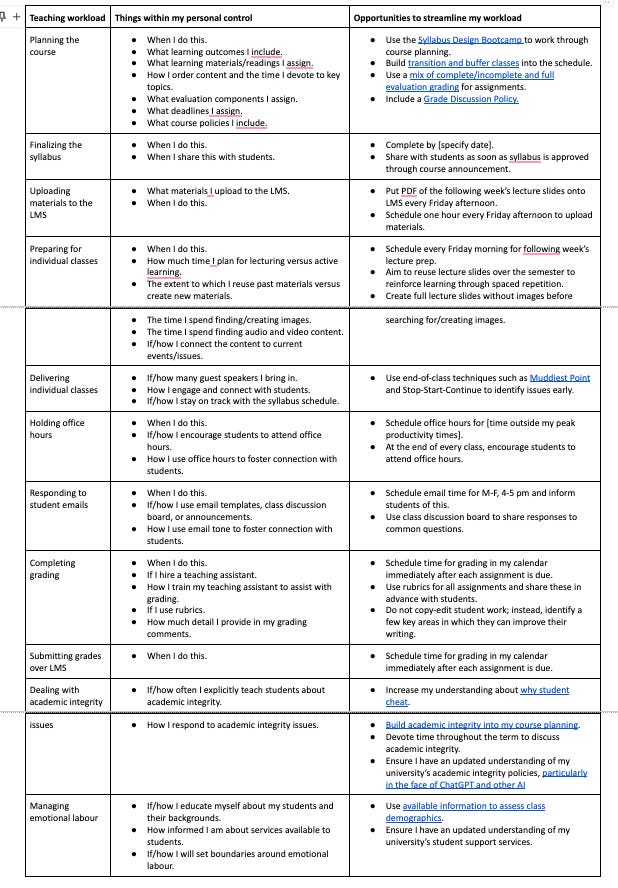How to streamline your teaching workload for next semester
Plus links to some additional teaching resources. Because September is coming! (sorry)
Hello and welcome to Academia Made Easier. I am so glad that you are here.
A good decade or so ago, I was heading into a semester from hell. I had pressing research commitments and a full teaching load that included a new course prep. I also had two young children, a perpetually messy house, and a chronic illness that would kick my ass if I didn't watch my well-being. Something had to give and I decided that it would be teaching. Specifically, I decided that I would abandon my self-imposed teaching standards and instead brace myself for negative teaching evaluations and a semester-long feeling of failure.
It ended up being one of my best teaching semesters ever.
That semester, I learned that I could reduce my teaching workload and still be an effective teacher. I discovered that some of the time I had previously been putting into teaching was of limited value. While this was initially a somewhat bitter pill to swallow, as I hated to admit how much time I had wasted in the past, the lesson made my work life and my teaching better in the long run.
If you suspect your own teaching workload is larger than it needs to be and want to cut it back, today’s small thing to try immediately is for you.
One Small Thing to Try Immediately: Identify strategies to streamline your teaching workload
Teaching can be joyful, creative, and rewarding work. It can also be draining, depleting, and time-consuming work. Streamlining your teaching workload will ideally aim to reduce the less energizing parts of the workload to allow you to focus your teaching work and time on the energizing parts.
Try the following:
1. Identify all aspects of your teaching workload. Think through your courses and list all of the teaching workload associated with the course, from syllabus design to submitting the final grades at the end of the semester. For each item, add the appropriate verb (for example, “responding to student email” rather than “email”).
Here is my own teaching workload list:
Planning the course
Finalizing the syllabus
Uploading materials to the learning management system (LMS)
Preparing for individual classes
Delivering individual classes
Holding office hours
Responding to student emails
Completing grading
Submitting grades over LMS
Dealing with academic integrity issues
Managing emotional labour
2. Determine your personal level of agency for each aspect of your teaching workload. Different aspects of your teaching workload will have different levels of personal agency. For example, you likely have zero control over when your individual classes are held (that MWF 8:30-9:20 am" time slot was locked in long ago!) but you may be able to select when your office hours are held.
For each element of your teaching workload, quickly list things you can control. I suggest using a table. Here is my own; note the use of “I” in each item to emphasize my agency:
3. Identify strategies to streamline your teaching workload. Now that you know what parts of your teaching workload you control, you can identify strategies to maximize your agency. This calls for another column in the table! To make it easier for you to read and adapt, I created a teaching workload worksheet for you to use; it allows you to start with the table below and adapt it to your own context.
4. Decide which strategies you want to adopt. Some of the strategies will have more workload impact for you than others, so select wisely and don’t aim to do everything. For me, reducing the amount of time I devoted to lecture prep was a major factor in streamlining my teaching workload. You know yourself and your context best. Use this information to identify strategies that will work for you.
Until next time…
What parts of your teaching workload are within your agency and what parts are completely out of your control? What are your own strategies to manage and streamline your teaching workload? I would love to hear your experiences and ideas. Please use the comment button below.
Stay well, my colleagues.
P.S. Since my last newsletter, I have another column to share with you: “Why you should start using open educational resources in your teaching”, coauthored with my colleague Heather M. Ross. Please check it out and share it with your networks!
If you find Academia Made Easier useful, consider supporting my chocolate habit at my Buy me a coffee page. This site allows readers to show their appreciation for the unpaid labour of writers like me, as well as artists and other creatives.
Have you checked out SophieGrace clothes yet? They are perfect for work and I love their comfortable machine-washable fabrics. Be sure to use my discount code AcademiaMadeEasier to get 15% off.





Quick heads up that I'm about to share this as a featured resource in the weekly newsletter I distribute for the University of Wyoming Science Communication Initiative! (I found your take on efficiency one of the most realistic and actionable I've ever seen. 🤗) You can find more about that WySCI newsletter here: https://www.uwyo.edu/wysci/programs-and-resources/newsletter.html
I love this! I’m moving institutions so I’ll have less teaching but a decent chunk of new teaching (which I’ll only teach this term, so it doesn’t make sense to make an extensive investment). Things that help - use calendly to let students book in for office hours so I’m not tied to my office, having 1 day for lecture prep (usually a day I’m already teaching) to keep it from expanding.